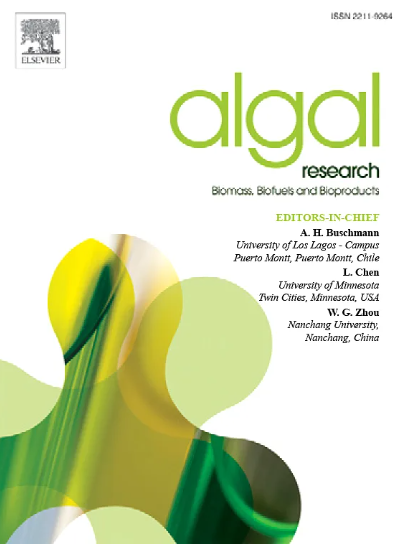Impact of Light Emitting Diode (LED) irradiation on growth, biochemical, antioxidant, and antibacterial activity of Scenedesmus sp
IF 4.5
2区 生物学
Q1 BIOTECHNOLOGY & APPLIED MICROBIOLOGY
Algal Research-Biomass Biofuels and Bioproducts
Pub Date : 2025-07-25
DOI:10.1016/j.algal.2025.104236
引用次数: 0
Abstract
Different LED wavelengths, red at 635 nm, blue at 447 nm and mixed wavelength irradiation either sequential red-blue or simultaneous red-blue for different exposure times (30, 60 and 90 min) were investigated for their effect on the growth, cell size, pigment accumulation, total carbohydrate and protein content of the micro alga, Scenedesmus sp. Bioactive secondary metabolites including phenolics, flavonoids, saponins and tannins were estimated. In addition, antioxidant and antibacterial activities of methanolic algal extract were detected. Exposure to 30 min of red wavelength and 60 min in case of blue and mixed wavelengths exhibited maximum growth of Scenedesmus sp. Exposure duration for 90 min to different wavelengths decreased cell size of Scenedesmus sp. as compared with non-treated cells. In addition, accumulation of chlorophyll a, b, and carotenoids was in the following order: M (sequential red-blue) > R + B (simultaneous red-blue) > blue > red > control. A noticeable increase in total carbohydrate content was observed in all treatments, except, the blue wavelength treatment (B) in comparison to the control. The maximum protein content was recorded under control and blue LED illumination. Flavonoid content was markedly increased in all treatments compared to the control however, phenolic content was significantly reduced. Exposure of Scenedesmus sp. to blue LED for 60 min was positively linked to the enhancement of bioactive antioxidants. Exposure of Scenedesmus sp. to red LED for 30 min was linked to strong antibacterial activity. Further research is required to elucidate the underlying mechanisms governing algal responses to specific wavelengths.
发光二极管(LED)辐照对花菜蛾生长、生化、抗氧化和抗菌活性的影响
研究了不同波长(红光635 nm,蓝光447 nm)和混合波长(连续红蓝或同时红蓝照射30、60和90 min)对微藻Scenedesmus sp生长、细胞大小、色素积累、总碳水化合物和蛋白质含量的影响,并对其次生代谢产物包括酚类物质、类黄酮、皂苷和单宁进行了测定。此外,还检测了甲醇藻提取物的抗氧化和抗菌活性。在红色和蓝色及混合波长下分别处理30min和60min时,景蝇的生长最大。与未处理的细胞相比,在不同波长下处理90min时,景蝇的细胞尺寸减小。此外,叶绿素a、b和类胡萝卜素的积累顺序为:M(顺序红蓝)>;R + B(红蓝同步)>;蓝色的祝辞红色比;控制。与对照相比,除蓝色波长处理(B)外,所有处理的总碳水化合物含量均显著增加。在控制和蓝色LED照明下记录最大蛋白质含量。与对照相比,各处理的黄酮类含量显著增加,而酚类含量显著降低。在蓝光LED下暴露60分钟与生物活性抗氧化剂的增强呈正相关。Scenedesmus spp .暴露在红色LED下30分钟具有较强的抗菌活性。需要进一步的研究来阐明控制藻类对特定波长反应的潜在机制。
本文章由计算机程序翻译,如有差异,请以英文原文为准。
求助全文
约1分钟内获得全文
求助全文
来源期刊

Algal Research-Biomass Biofuels and Bioproducts
BIOTECHNOLOGY & APPLIED MICROBIOLOGY-
CiteScore
9.40
自引率
7.80%
发文量
332
期刊介绍:
Algal Research is an international phycology journal covering all areas of emerging technologies in algae biology, biomass production, cultivation, harvesting, extraction, bioproducts, biorefinery, engineering, and econometrics. Algae is defined to include cyanobacteria, microalgae, and protists and symbionts of interest in biotechnology. The journal publishes original research and reviews for the following scope: algal biology, including but not exclusive to: phylogeny, biodiversity, molecular traits, metabolic regulation, and genetic engineering, algal cultivation, e.g. phototrophic systems, heterotrophic systems, and mixotrophic systems, algal harvesting and extraction systems, biotechnology to convert algal biomass and components into biofuels and bioproducts, e.g., nutraceuticals, pharmaceuticals, animal feed, plastics, etc. algal products and their economic assessment
 求助内容:
求助内容: 应助结果提醒方式:
应助结果提醒方式:


